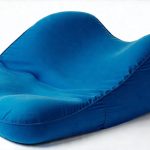Prolonged sitting is an inescapable reality for many in today’s world. From office workers glued to their desks, students immersed in study sessions, to drivers spending hours on the road, our bodies are often subjected to extended periods of pressure and immobility. This can lead to discomfort, fatigue, even chronic musculoskeletal issues over time. Traditional seat cushions offer some level of padding, but they frequently lack a holistic approach that addresses not just comfort, but also promotes well-being during these long stretches. Increasingly, people are turning towards herbal-infused seat cushions as a more thoughtful and potentially beneficial solution – integrating the ancient wisdom of botanical remedies with modern ergonomic design.
The appeal lies in the promise of something more than simple cushioning. Herbal infusions aren’t about quick fixes; they’re rooted in traditional medicine systems that recognize the interconnectedness of body, mind, and environment. Herbal seat cushions aim to leverage this understanding by incorporating plants known for their calming, restorative, or circulation-enhancing properties directly into the seating experience. It’s a subtle yet potentially powerful way to create a more supportive and nurturing environment even while enduring long periods of sitting – a proactive approach to mitigating the negative effects of sedentary lifestyles. This isn’t about replacing proper posture or regular movement; it’s about adding another layer of support during unavoidable long sits. If you’re prone to discomfort, consider exploring techniques for minimizing tension while seated.
The Science & Tradition Behind Herbal Infusions
The core concept behind herbal-infused cushions is rooted in phytotherapy, the use of plants for medicinal purposes. For centuries, cultures around the globe have utilized herbs to address a wide range of ailments and promote overall health. Aromatherapy plays a significant role – the scent of certain herbs can influence mood, reduce stress, and even ease muscle tension. Beyond aroma, however, many herbs contain compounds that are believed to stimulate circulation or offer anti-inflammatory benefits when applied topically (or in this case, through prolonged contact with the skin). It’s important to understand that scientific research specifically on herbal seat cushions is limited; much of the evidence supporting their potential benefits comes from studies focusing on individual herbs and aromatherapy. For those interested in holistic health practices, exploring restorative plant meals can further enhance wellbeing.
The choice of herbs used within a cushion isn’t arbitrary. Commonly incorporated botanicals include lavender (renowned for its calming properties), chamomile (known for relaxation), peppermint (which can be invigorating and aid digestion, potentially counteracting the effects of prolonged sitting) rosemary (believed to improve focus and circulation), and even certain citrus peels (for mood-boosting aromatics). The method of infusion varies – some cushions contain loose herbs within a fabric pouch, allowing direct contact; others utilize herbal extracts or oils incorporated into the cushion’s filling. The quality of the herbs is paramount, with organic and sustainably sourced options being preferred to ensure purity and potency. Consider pairing this approach with daily food choices that support overall health.
Herbal infusions aren’t intended to be miracle cures. They are best understood as a complementary approach – one that can potentially enhance comfort and well-being alongside other healthy habits like regular stretching, proper posture, and movement breaks. It’s also worth noting that individual responses to herbs vary significantly; what works wonderfully for one person may have minimal effect on another.
Cushion Construction & Material Considerations
Beyond the herbal infusion itself, the construction of the cushion plays a crucial role in its effectiveness. The base material – often memory foam, latex, or buckwheat hulls – determines the level of support and pressure relief offered. Memory foam is popular for its conforming ability, adapting to the user’s shape; however, it can retain heat which some find uncomfortable. Latex provides excellent support and breathability but may be less affordable. Buckwheat hulls offer a firm, naturally supportive base with good airflow, but they can be noisy. To further address discomfort during long sits, explore quiet sitting routines designed for tension recovery.
The outer fabric is equally important. Breathable materials like cotton or linen are preferred to prevent overheating and allow for air circulation. Durability is also a key factor – the cushion should withstand daily use without showing excessive wear and tear. The method of incorporating herbs into the cushion varies significantly between manufacturers. Some cushions have pockets containing dried herbs, allowing direct contact; others infuse the filling material (like memory foam) with herbal extracts or oils during production. The method impacts both the intensity and longevity of the herbal effect. A well-designed cushion will balance comfort, support, durability, and effective herbal infusion to provide a holistic seating experience. Remember that proper hydration is also key; consider reviewing optimal hydration practices.
Selecting the Right Herbal Blend for Your Needs
Choosing the appropriate herbal blend is perhaps the most personalized aspect of selecting an herbal seat cushion. Different herbs offer different benefits, so it’s important to consider your individual needs and preferences.
- If stress relief is your primary goal, look for cushions infused with lavender, chamomile, or sandalwood. These herbs are known for their calming and relaxing properties, helping to ease tension during long sitting periods.
- For improved focus and mental clarity, rosemary, peppermint, or citrus peels might be a good choice. These invigorating scents can help sharpen the mind and boost concentration.
- If you’re prone to discomfort or muscle fatigue, consider cushions with herbs believed to support circulation – such as ginger or cayenne (though these are less common in seat cushions due to their potency).
It’s also wise to be mindful of any allergies or sensitivities you may have before choosing a cushion. Always check the ingredient list carefully and avoid cushions containing herbs you know you react negatively to. Consider starting with a blend that combines several complementary herbs – offering a wider range of potential benefits.
Care & Maintenance for Longevity
Proper care is essential to maintain the effectiveness and lifespan of an herbal seat cushion. The specific cleaning instructions will vary depending on the materials used, but generally, spot cleaning with mild detergent is recommended. Avoid harsh chemicals or abrasive cleaners, which can damage the fabric and diminish the herbal infusion. To complement this, explore home techniques for relieving pressure after long periods of sitting.
- Regularly fluffing the cushion helps to redistribute the herbs and maintain its shape.
- If the cushion contains loose herbs, check periodically for any loss of aroma. You may be able to refresh the scent by gently massaging the herbs or adding a few drops of essential oil (ensure it’s compatible with the filling material).
- Store the cushion in a cool, dry place when not in use to prevent mold or mildew growth.
Over time, the herbal infusion will naturally fade. This is normal and doesn’t necessarily mean the cushion has lost all its benefits – the physical support and comfort remain. However, if you notice a significant decrease in aroma or effectiveness, it may be time to consider replacing the cushion or replenishing the herbs (if possible).
Beyond Cushions: Integrating Herbal Support into Your Routine
Herbal-infused seat cushions are just one way to incorporate botanical benefits into your daily life. Consider these complementary approaches to enhance your overall well-being during long sitting days:
- Aromatherapy Diffusers: Use a diffuser with calming essential oils like lavender or chamomile in your workspace to create a relaxing atmosphere.
- Herbal Teas: Sip on herbal teas throughout the day to stay hydrated and enjoy the soothing benefits of botanicals. Peppermint tea can aid digestion, while chamomile tea promotes relaxation.
- Regular Movement Breaks: Even short breaks every 30-60 minutes to stretch, walk around, or practice simple yoga poses can significantly reduce muscle fatigue and improve circulation.
- Mindfulness Exercises: Incorporate mindfulness techniques like deep breathing exercises or meditation to manage stress and promote mental clarity.





















